Multirelational Twitter Bot Detection using Graph Neural Networks
Chris Pollett
CS Dept, SJSU
Joint Work with:
Ketan Jadhav (Graduate), Petros Potikas, and Katerina Potika
July 22, 2025
Outline
- Introduction
- Motivation
- Related Works
- Methodology
- Dataset
- Experiment Set-Ups
- Results
- Conclusion and Future Work
Introduction
Social media and 'X' aka Twitter
- Social media is one of the most influential features of the internet era
- X (formerly known as Twitter) is a text based social media platform
- Over 500 million monthly active users worldwide use X
- Users can post tweets (text posts), like, comment and share content of other people.
What are Bots?
- Bots are automated programs controlled by algorithms to post certain content or behave in a certain way.
- Initial uses of social media bots involved things like posting local area weather updates from automated accounts.
- As the technology grew, bots were used for customer service, subtasks on X, or even virtual assistants.
- Bots generate between 20.8% and 29.2% of the content posted to Twitter [1] and huge revenue through automated ads
- They have also been used maliciously throughout their history
- Spam Bots are used to post large volume of tweets to influence people in a certain way
An Example of a bot generated tweet vs that of a real user.
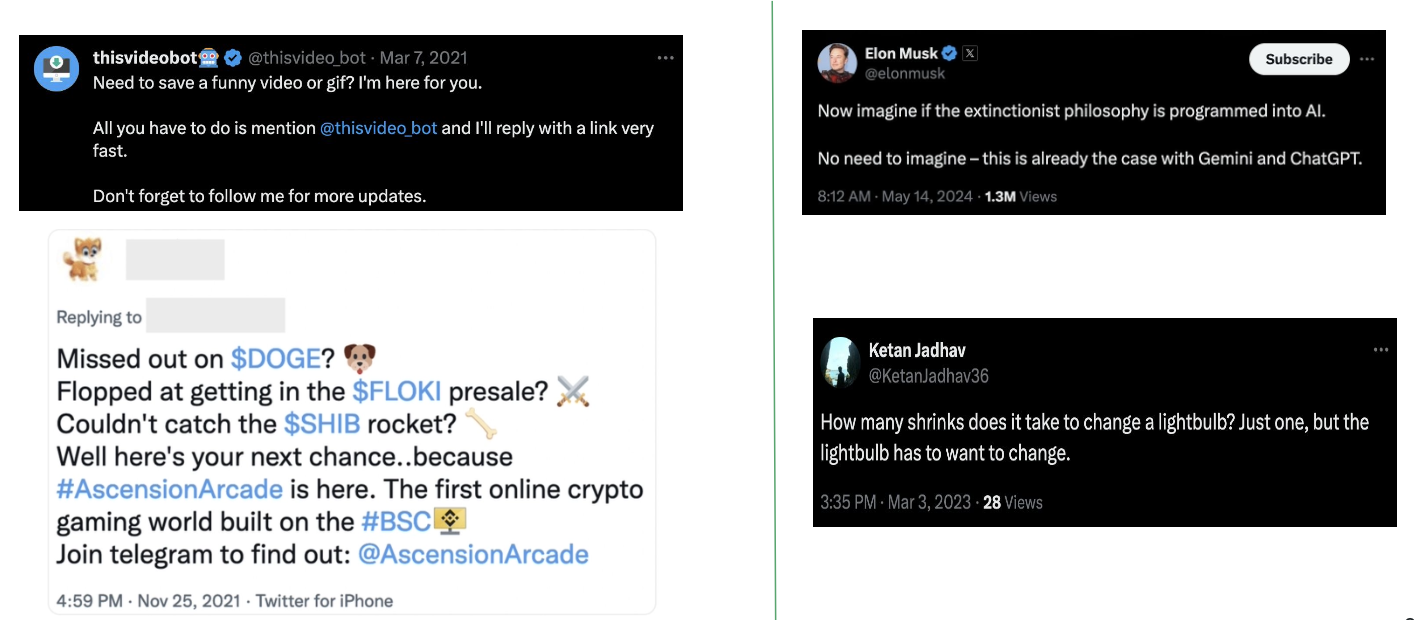
Motivation
Usage of Bot Accounts
- Good useful cases of bot accounts (WeatherBot, Customer Query)
- Malicious purposes of bot usage
- Spreading misinformation (Spam Bots)
- Cyberbullying
- Scams, Frauds
- Cyber attacks
- During the COVID 19 pandemic, more than 40% of the accounts tweeting about re-opening were bots. [2]
- In context of the 2018 US Midterms, Luceri et al [3] classified 21.1 percent of election posting accounts as bots, which in turn generated 30.6 percent of the tweets
- Scam bot accounts are used in a wide variety of cryptocurrency pump and dump and Ponzi schemes are detailed by Nizolli, et al [4].
- Bad bots often misrepresent themselves as not being bots, so it is useful to be able to say whether something is a bot of not.
Results of Botometer [5] application when given a few user ids as input

- Botometer was a Twitter, pre-X, example of a bot-detection tool from U of I's Observatory on Social Media.
- KetanJadhav36 is a real user, but is barely classified as real, showing that relying mainly on user meta data and temporal patterns in tweets does not suffice to identify bots. Especially, as bot become more sophisticated and try to match user profiles with this regard.
- This is why looking at the graph structure of social network is important.
Related Work
Previous Work on Bot Detection
- Profile properties:
- follower/following count, other metadata
- ML algorithms for classification
- Tweets:
- NLP to process tweets by accounts
- ML and Deep Learning for classification
- Graph Structure:
- Leveraging graph structure to obtain features
- Using GNNs to directly work on graphs
Prior Work Summary
| Title | Year | Approach | Datasets |
|---|---|---|---|
| BotFinder: a novel framework for social bots detection in online social networks based on graph embedding and community detection [6] | 2022 | User profile data and relations classified using ML algorithms | ByteDance Security AI Challenge |
| MRLBot: Multi-Dimensional Representation Learning for Social Media Bot Detection [7] | 2023 | User relation with neural networks | Cresci-15 |
| Detect Me If You Can: Spam Bot Detection Using Inductive Representation Learning [8] | 2019 | Profile properties with neighborhood relations with representational learning | Cresci-15 |
| SATAR: A Self-supervised Approach to Twitter Account Representation Learning and its Application in Bot Detection [9] | 2021 | Tweet, metadata and neighborhood relations with self-supervised learning | TwiBot-20, Cresci-17, PAN-19 |
| Heterogeneity-Aware Twitter Bot Detection with Relational Graph Transformers [10] | 2021 | Focus on neighborhood relation graphs with GNNs | Twibot-20 |
- Of these approaches the relational graph neural net approaches such as [10] perform best. [7] also uses relations and a neural net framework to learn bot graphical behavior.
- In our study, we explore GNN approaches which mainly leverage characteristics of relations and avoid more time costly to compute features based on tweet contents to see if we can still get good results. We do consider some text features based on User Bios.
Techniques
Graph Neural Networks
- Several papers (Li et al. 2015, Schlichtkrull et al 2017 Kipf Welling 2017, Velickovic et al 2018) have proposed neural net layer types to handle graphical data.
- These were shown by Bronstein et al 2021 to be all formulatable using message passing neural network (MPNN) layers.
- Given a graph G=(V,E). Let xu, eu,v denote the features of a node u ∈ V, and and edge (u,v) ∈ E.
- Then an MPNN layer computes a vector valued function
hu = φ (xu, Symv ∈ Nu(ψ(xu, eu,v)) )
where φ and ψ are differentiable functions, and Sym is a symmetric function (a real-valued function whose value does not depend on the order of its arguments) - A single layer of this kind allows information to be shared with immediate neighbors in the graph.
- Using multiple such layers, allows one to learn how farther distant nodes should influence each other.
- The particular choice of φ, ψ, and SYM depends on the type of GNN algorithm.
GNN Algorithms We Tried
- Graph Convolutional Neural Networks (GCN) [11]
- Relational Graph Convolutional Neural Networks (RGCN) [12]
- GraphSAGE [13]
- Graph Attention Networks (GAT) [14]
GCNs and RGCNs
- GCNs take the product of a matrix of trainable weights W and feature vectors X as ψ on the previous slide, multiply this with a degree normalized adjacency matrix to compute a Sym function, and finally apply an activation function (usually ReLU) for φ
- If one stares at this funny, because of its use of a normalized adjacency matrix, the effect can be thought first-order approximation of a spectral filter on the graph, hence why called a convolution network.
- By stacking layers of this in different ways and of different depths one can control how different nodes are preocessed together like feature maps.
- These can be further combined to help identify higher order secondary patterns.
- Notice though this set-up does not use edge features.
- RGCNs modify ψ and Sym to allow for processing of edges belonging to a relation R.
GraphSAGE and GAT
- GraphSAGE uses depth K GNN layers where layer h0u is xu and for layer 1 ≤ k ≤ K computes and hkN(u) as an aggregation function such as mean applied to hk-1u, and hku as a normalization of an activation layer applied to a training weight matrix multiplied with the concatenation of hk-1u and hkN(u).
- There is flexibility in selecting aggregating function
- This approach leads to inclusion of local and global properties
- GAT uses an attention mechanism combined with GNN layers, assigning learned importances to layer features based on context
- One can has multiple attention heads, facilitating independent learning.
GNN Approaches Summary
| GCN | R-GCN | GraphSAGE | GAT | |
|---|---|---|---|---|
| Use Case | Basic convolutional graph-based learning | Handles graphs with multiple edge types | Supports scalable inductive learning for large graphs | If need attention mechanism for varying neighbor importance |
| How Works | Captures local graph structure | Captures multi-relational graph structure | Captures local structure and supports inductive learning | Captures complex relationships with attention |
| Aggregation | Weighted sum of neighbor features | Weighted sum of neighbor features for each relation type | Sample and aggregate (mean, LSTM, pooling) | Attention-weighted sum of neighbor features |
Natural Language Processing
- To make embeddings for text data in our training sets (for User Bio), we use RoBERTa: A Robustly Optimized BERT Pretraining Approach [15].
- Compared to the earlier BERT, this model has Extended Pretraining and Data Scale:
- RoBERTa extends BERT's pretraining time and uses ten times more data
- 160GB of uncompressed text compared to 16GB used to train BERT
- Optimized Training Techniques:
- Eliminates the Next Sentence Prediction (NSP) task,
- Focuses on more dynamic masking of input tokens, and
- Uses larger mini-batches
- Dimension Size:
- 768 for the base models (RoBERTa-base)
Methodology
Process Flowchart:
Multirelational Twitter Bot Detection using Graph Neural Networks
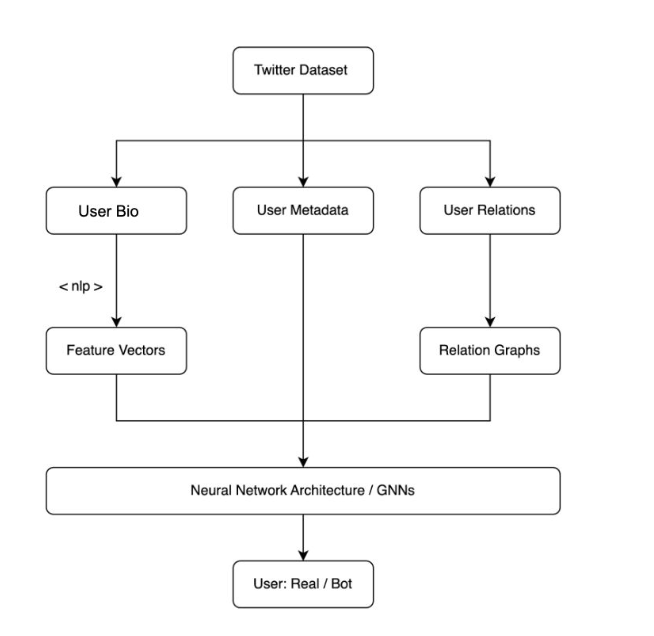
- GitHub:
https://github.com/jketan/botgnn

- All of our networks used two GNN layers (GraphSage depth 2) with some ReLU or leaky ReLU layers before and after the GNN layers.
Dataset
Dataset
| Users | Bots | Tweets | Edges | |
|---|---|---|---|---|
| Twibot-22 [16] | 860057 | 139943 | 86764167 | 170185937 |
| Subset Used | 139943 | 139943 | N/A | 2349098 |
| Relation | Edges |
|---|---|
| Following | 2626979 |
| Follower | 1116655 |
| Post | 40887365 |
| Like | 595794 |
Feature Vector
- For us, these will be tuples of data associated with a node in a graph (such a node corresponds to a user).
- Four types of information processed to obtain feature vectors:
- User bio using NLP technique RoBERTa
- Numerical properties of user profile like follower count, following count, number of active days, number of tweets, screen name length
- Categorical properties of user profile like does account have a profile image, is the account verified, is the account protected
- This information is concatenated in the initial layer of the architecture to be used as GNN features.
Experiment Set-Ups
Features Extracted from Dataset
- Categorical Properties:
- is the user account protected
- is the user account verified
- does the user have a default profile image or a custom one
- Edge Index and Edge type:
- From user relations
- Numerical Properties:
- followers count
- active days
- length of the user screen name
- following count
- number of tweets posted
- Description:
- User bio
We also create a synthetic relationship, we call Interaction to indicate whether a given user liked a post of another given user. We can modify this further to track the number of liked posts.
GNN models
- Used pyTorch Geometric neural networks library for GNN models
- Defined each model as a combination of layers that processed and combined the various input features along with the GNN model
- Used the following hyper parameters for training through tuning:
- embedding size = 32
- dropout = 0.1
- learning rate = 0.01
- weight decay = 0.05
- loss = Cross Entropy Loss
- activation = ReLu
Results
Evaluation Metrics
- Accuracy: Accuracy measures the proportion of correct predictions out of all predictions made.
- Precision: Precision measures the proportion of true positive predictions out of all positive
predictions made.
- Recall: Recall (or Sensitivity) measures the proportion of true positive predictions out of all actual
positive cases.
- F1 Score: The F1 Score is the harmonic mean of precision and recall, balancing the two metrics
Accuracy Results
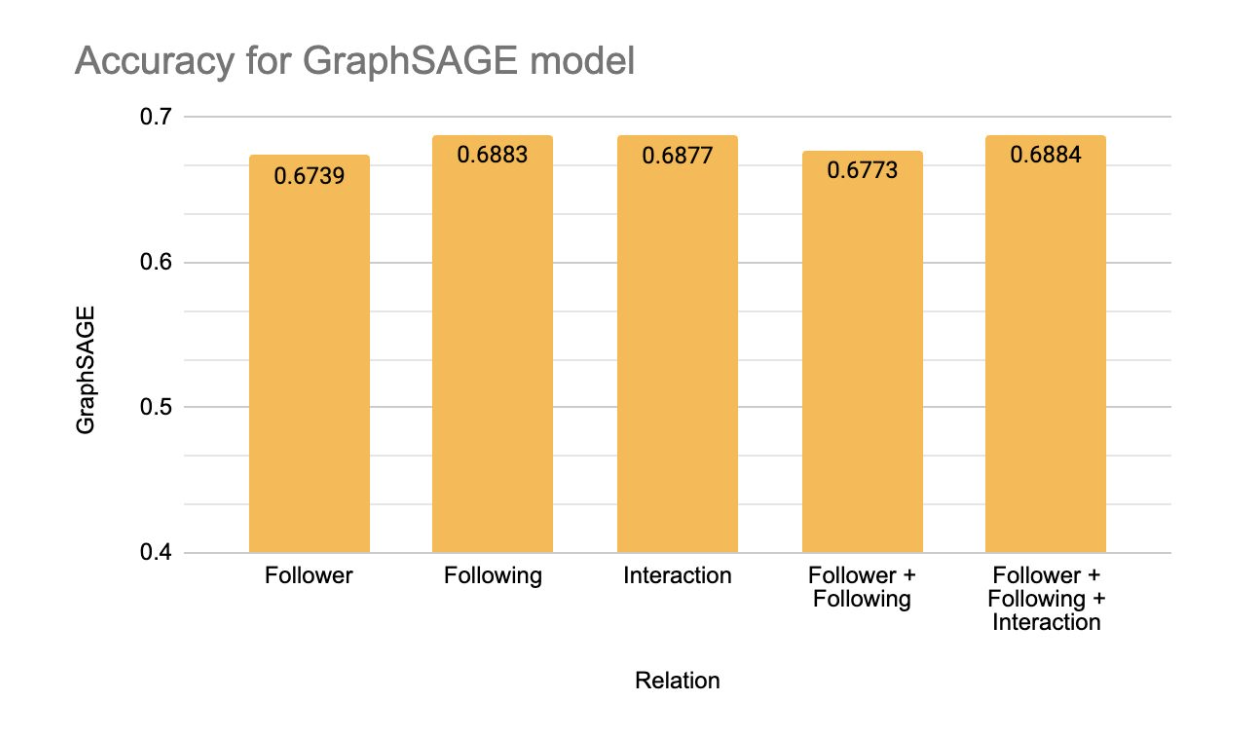
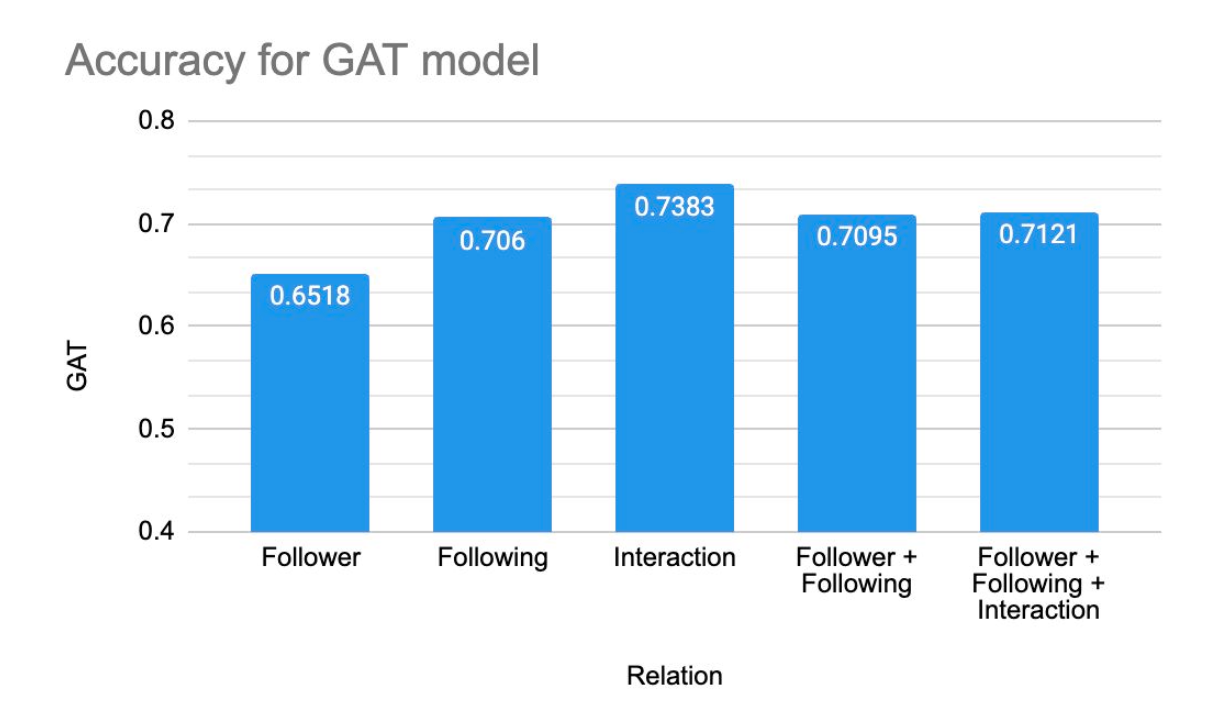
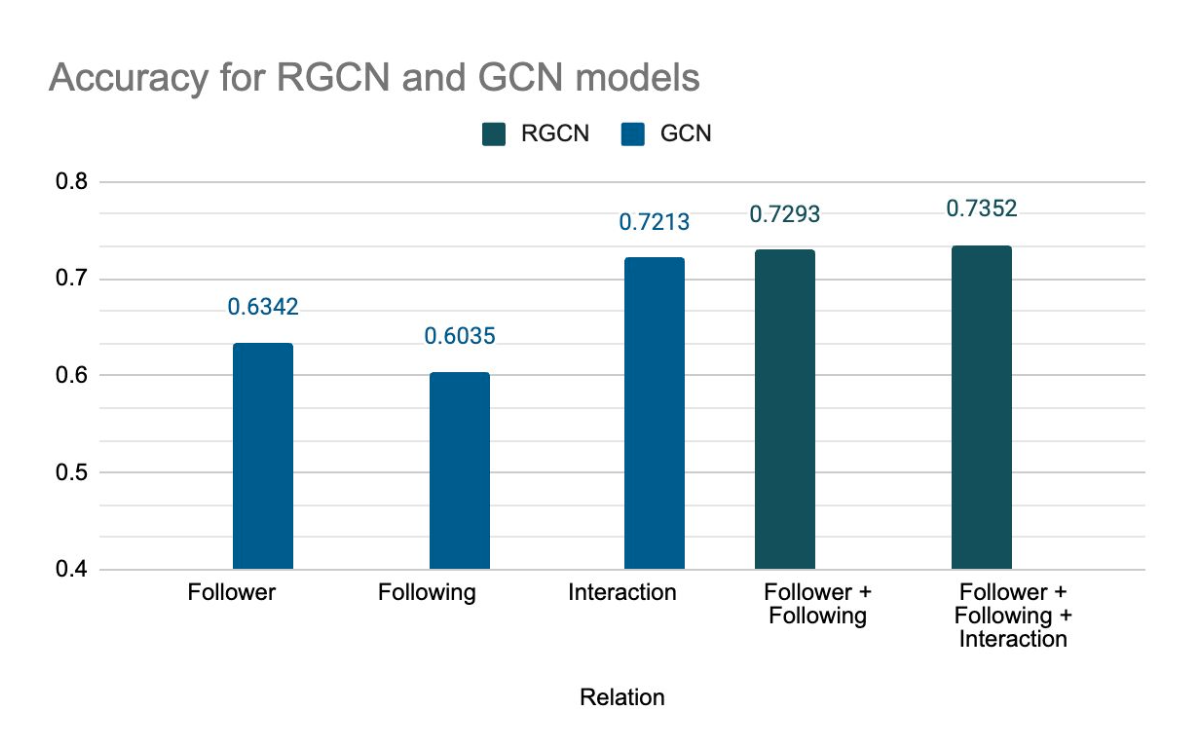
Takeaways: GraphSAGE performs similar on all relations GAT for interaction relation is the best followed by RGCN for follower + following
Precision Results
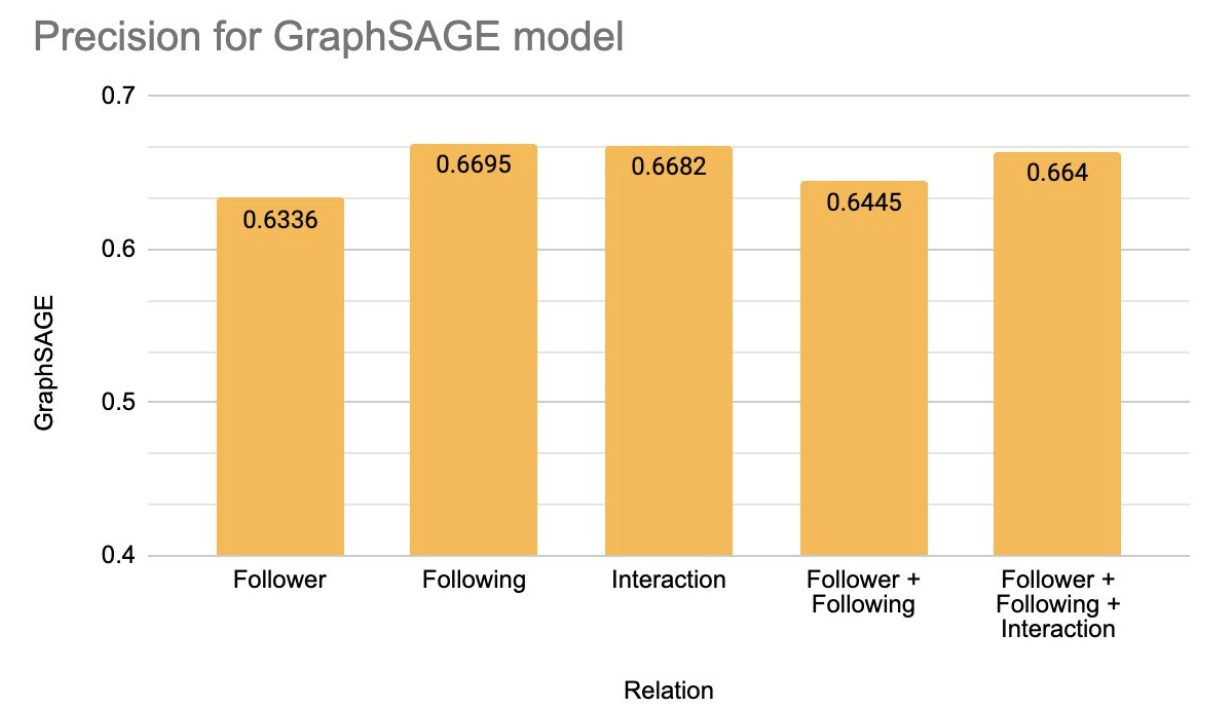
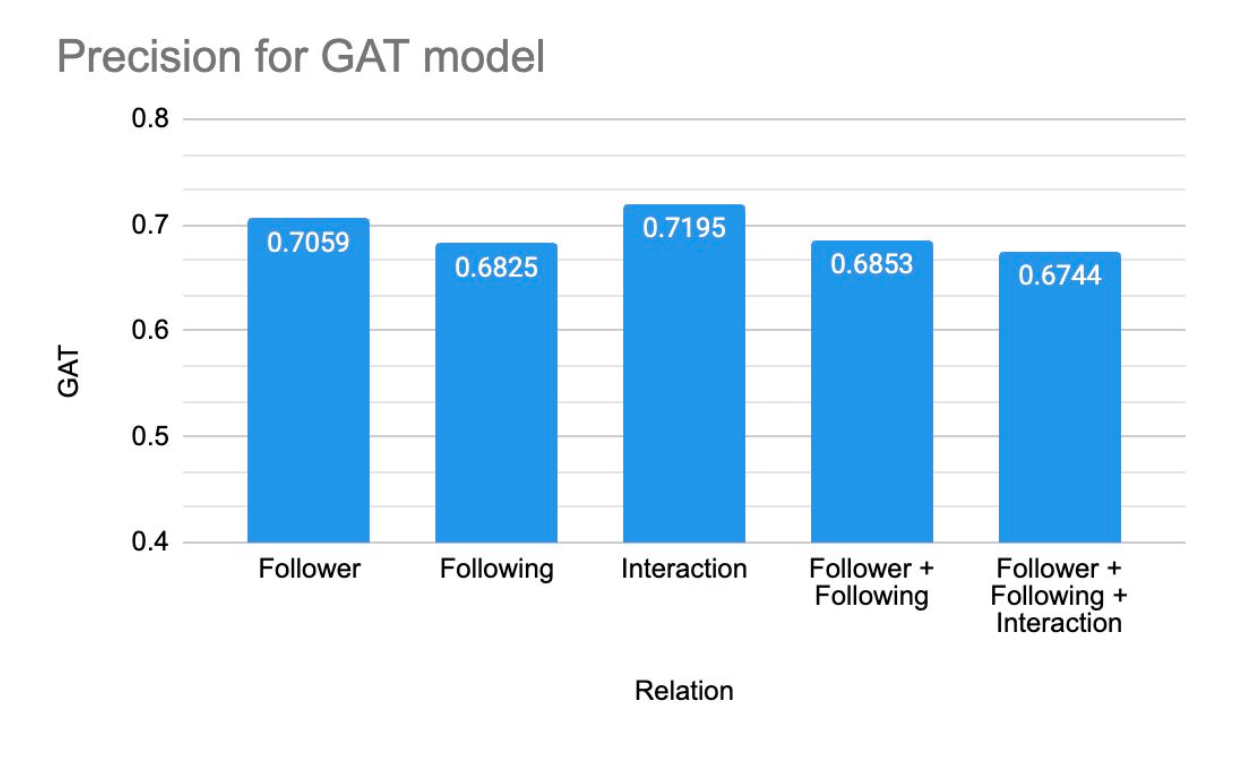
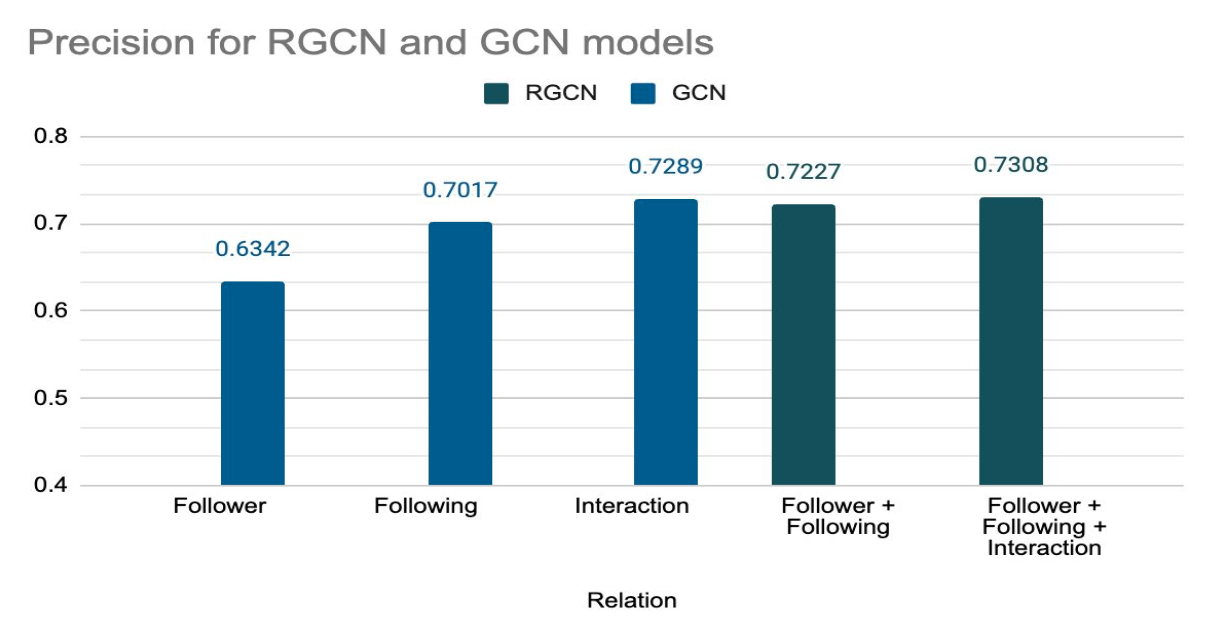
Takeaways: GraphSAGE performs similar on all relations GAT for interaction relation is the best followed by RGCN for follower + following + interaction
Recall Results

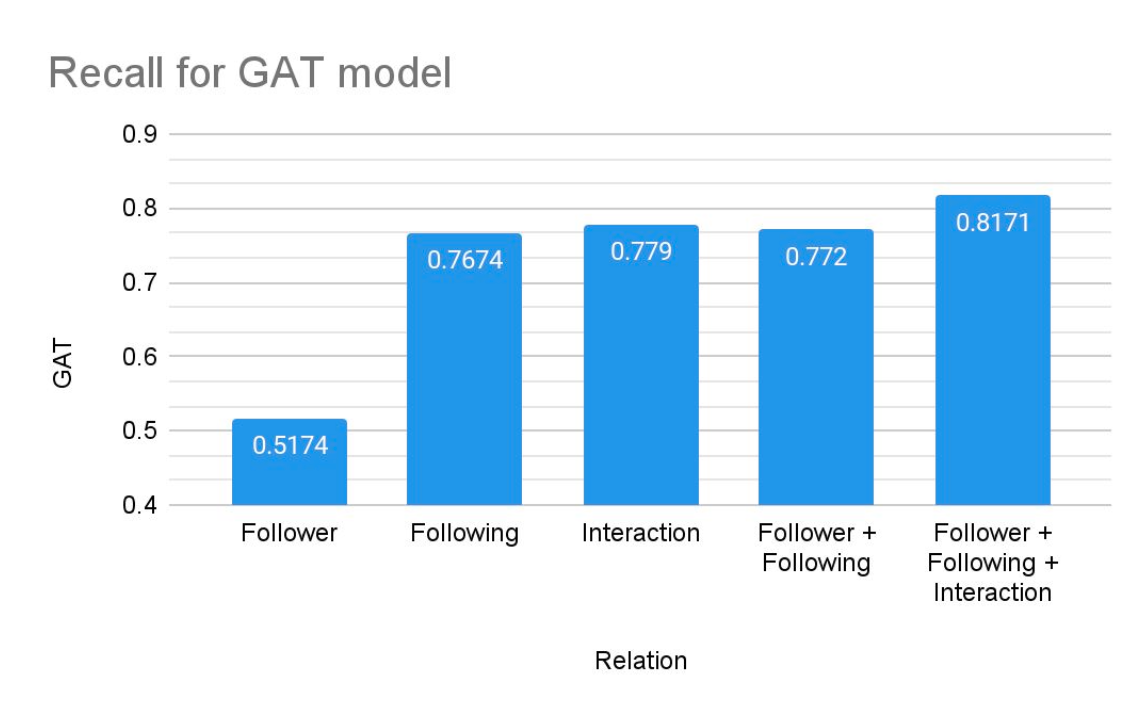
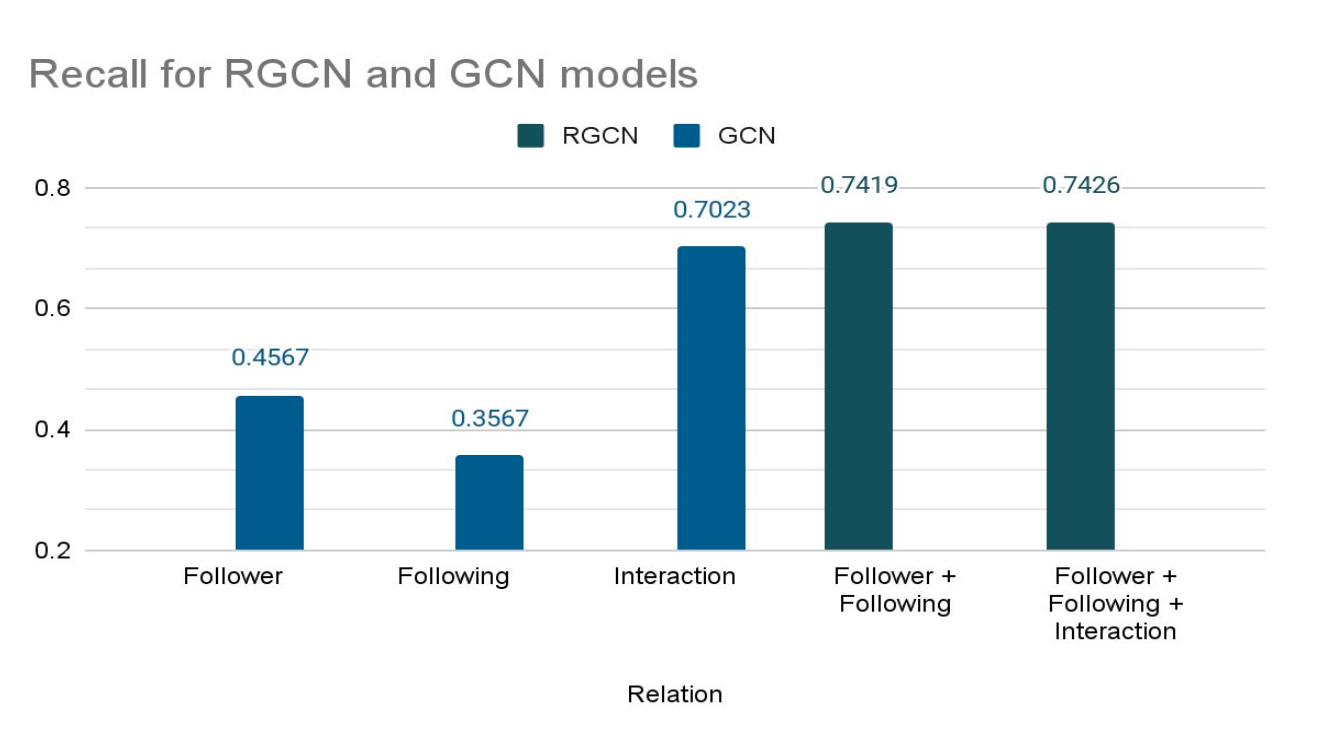
Takeaways: GAT for follower + following + interaction relation is the best followed by RGCN for follower + following + interaction
F1-Score Results
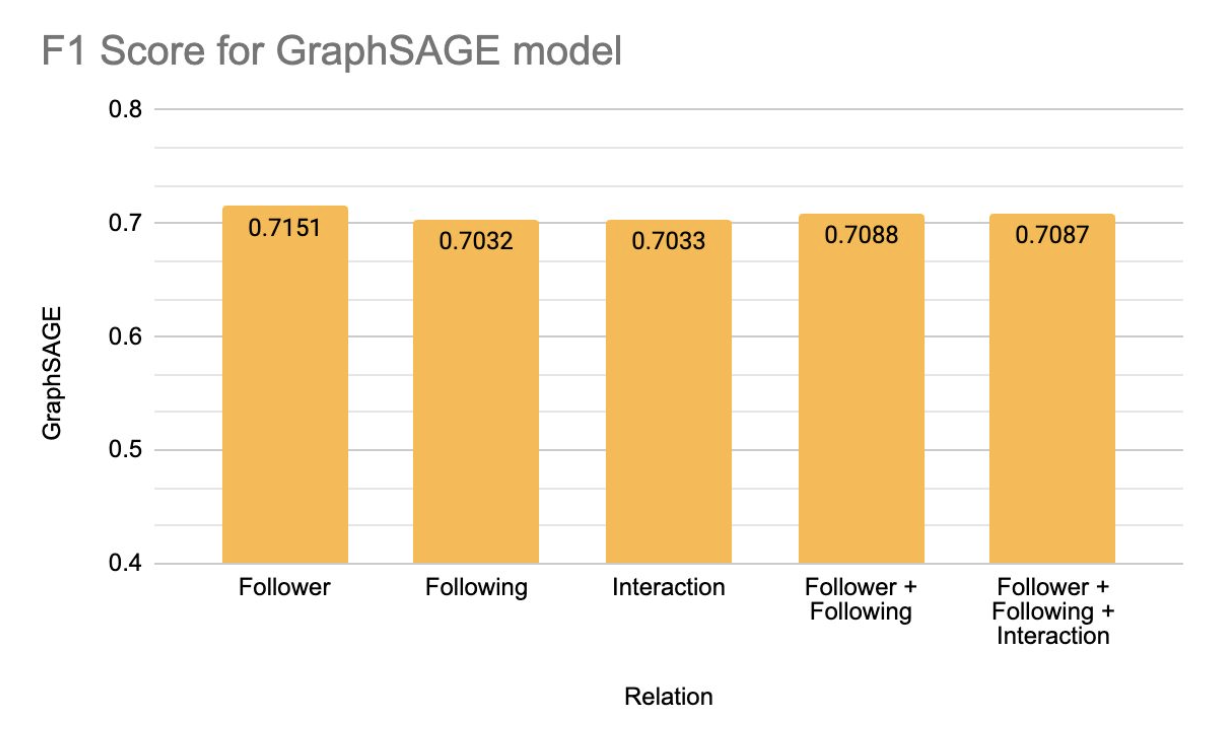
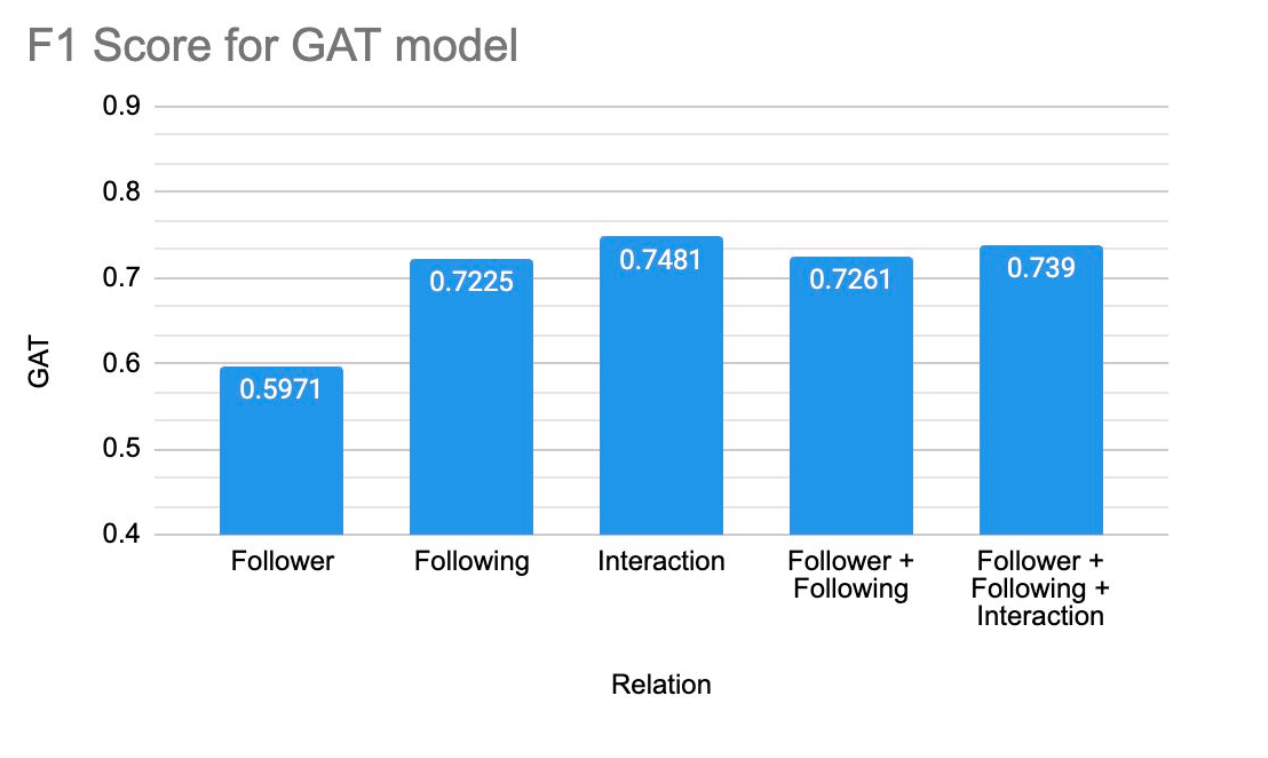
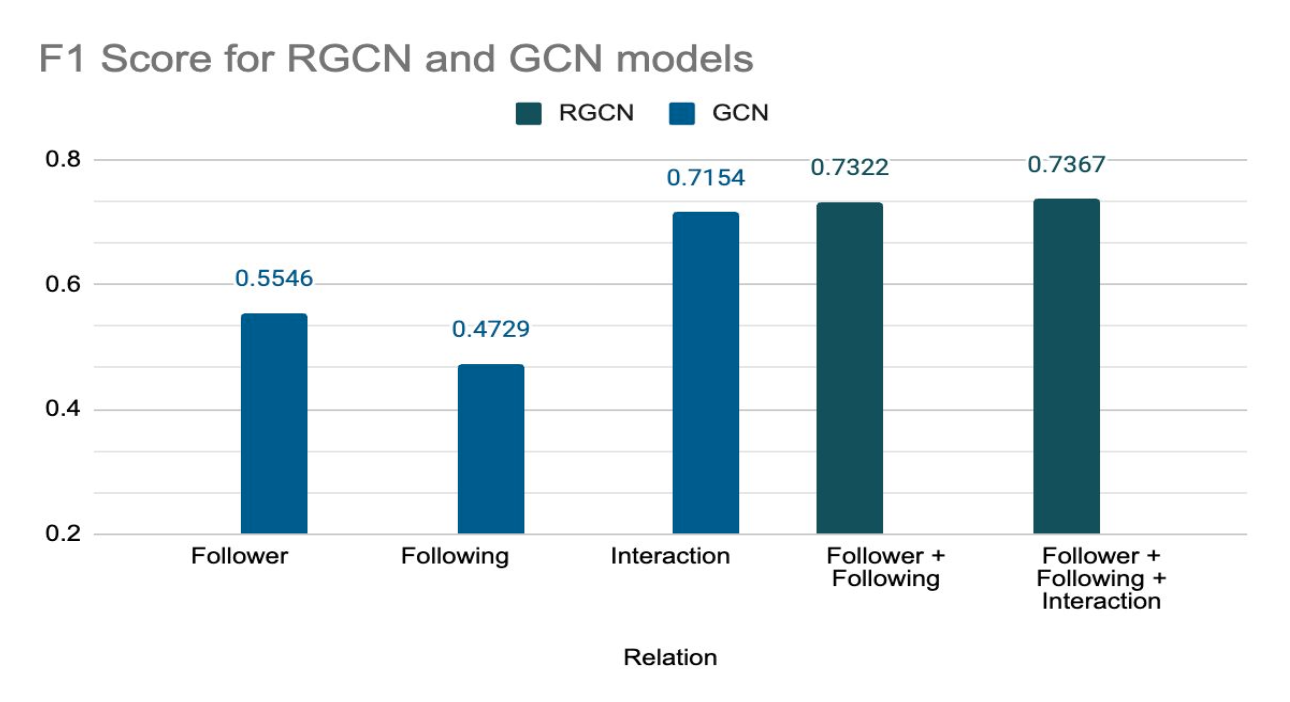
Takeaways: GraphSAGE performs similar on all relations GAT for interaction relation is the best followed by RGCN for follower + following
Conclusion and Future Work
Conclusion
- Twitter bots can be used for good and malice, identifying bots is important.
- Various techniques can be used to identify bots:
- User profile details and Machine Learning
- Natural Language Processing
- User relations and Graph Neural Networks
- Leveraged GNNs to understand complex relationships of the account social network.
- Combined text based data, user account details and graphs to develop strong classification models.
- Used accuracy, precision, recall and F1-score to evaluate the models
- Graph Attention Network model with interaction relation constructed by combining the post and like relation gave the highest accuracy of 73.83
Future Work
- Processing account tweets using NLP techniques and using them as features
- Leveraging Heterogeneous GCNs to understand the relationship between node accounts and tweets
- Using weighted edge graphs between users by determining strength of relations
- Sub-classification of bot accounts into categories
References
References
[1] ''Estimating twitter's bot-free monetizable daily active users,'' https://www.similarweb.com/blog/insights/social-media-news/twitter-bot-research/, 2022.
[2] Alison Grace Johansen. ''What's a Twitter bot and how to spot one'', https://us.norton.com/blog/emerging-threats/what-are-twitter-bots-and-how-to-spot-them
[3] Luceri, et al. ''View of Evolution of bot and human behavior during elections'' (2019)
[4] Nizzoli, et al. ''Charting the Landscape of Online Cryptocurrency Manipulation'', (2020)
[5] - K.-C. Yang, E. Ferrara, and F. Menczer. ''Botometer 101: Social bot practicum for computational social scientists,'' Journal of Computational Social Science, vol. 5, no. 2, pp. 1511--1528, 2022.
[6] Li, Shudong. Zhao, Chuanyu. Li, Qing. Huang, Jiuming. Zhao, Dawei. Zhu, Pei can. ''BotFinder: A Novel Framework for Social Bots Detection in Online Social Networks Based on Graph Embedding and Community Detection.'' 10.21203/rs.3.rs-1871702/v1. (2022).
[7] Zeng, F. Sun, Y. Li, Y. ''MRLBot: Multi-Dimensional Representation Learning for Social Media Bot Detection''. Electronics 2023, 12, 2298. https://doi.org/10.3390/electronics12102298 (2023)
[8] Alhosseini, Seyed. Bin Tareaf, Raad. Najafi, Pejman. Meinel, Christoph. ''Detect Me If You Can: Spam Bot Detection Using Inductive Representation Learning.'' 10.1145/3308560.3316504. (2019).
References
[9] Shangbin Feng. Herun Wan. Ningnan Wang. Jundong Li. Minnan Luo. SATAR: A Self-supervised Approach to Twitter Account Representation Learning and its Application in Bot Detection. In Proceedings of the 30th ACM International Conference on Information & Knowledge Management (CIKM '21). Association for Computing Machinery, New York, NY, USA, 3808--3817. https://doi.org/10.1145/3459637.3481949 (2021)
[10] Shangbin Feng. Zhaoxuan Tan. Rui Li. Minnan Luo. ''Heterogeneity-aware Twitter Bot Detection with Relational Graph Transformers''. https://doi.org/10.48550/arXiv.2109.02927
[11] T. N. Kipf and M. Welling, ''Semi-supervised classification with graph convolutional networks,'' CoRR, vol. abs/1609.02907 (2016)
[12] M. Schlichtkrull. T. N. Kipf. P. Bloem. R. van den Berg. I. Titov, and M. Welling. ''Modeling relational data with graph convolutional networks.'' (2017)
[13] P. Velickovic. G. Cucurull. A. Casanova. A. Romero. P. Lio. Y. Bengio. ''Graph attention networks.'' (2018)
[14] W. L. Hamilton. R. Ying. J. Leskovec. ''Inductive representation learning on large graphs.'' CoRR, vol. abs/1706.02216, (2017)
[15] Y. Liu. M. Ott. N. Goyal. J. Du. M. Joshi. D. Chen. O. Levy. M. Lewis. L. Zettlemoyer. V. Stoyanov. ''Roberta: A robustly optimized BERT pretraining approach.'' CoRR, vol. abs/1907.11692 (2019)
[16] S. Feng, et al. ''Twibot-22: Towards graph-based twitter bot detection.'' (2023)